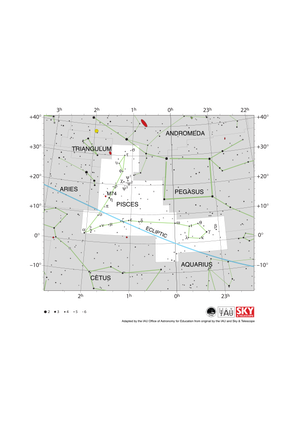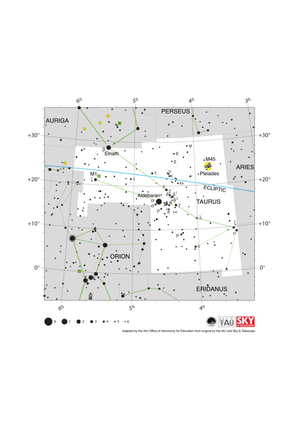Glossarbegriffe: Widder
Description: Der Widder (Aries) ist das kleinste Sternbild des Tierkreises. Die Sterne, aus denen dieses Sternbild besteht, befinden sich in dem Teil des Himmels, der die Ekliptik (die Ebene, die durch die Umlaufbahn der Erde um die Sonne definiert ist) schneidet. Von der Erde aus können wir also regelmäßig die Planeten und auch die Sonne im Sternbild Widder finden. Im Fall der Sonne ist dies von Mitte April bis Mitte Mai der Fall (zu dieser Zeit können wir die Sterne des Sternbilds natürlich nicht sehen). Der Widder ist eines der 88 modernen Sternbilder, die von der Internationalen Astronomischen Union festgelegt wurden, aber er geht viel weiter zurück. Bereits im zweiten Jahrhundert war der Widder eines der 48 Sternbilder des Astronomen Claudius Ptolemäus.
Zugehörige Glossarbegriffe:
See this term in other languages
Term and definition status: The original definition of this term in English have been approved by a research astronomer and a teacher The translation of this term and its definition is still awaiting approval
The OAE Multilingual Glossary is a project of the IAU Office of Astronomy for Education (OAE) in collaboration with the IAU Office of Astronomy Outreach (OAO). The terms and definitions were chosen, written and reviewed by a collective effort from the OAE, the OAE Centers and Nodes, the OAE National Astronomy Education Coordinators (NAECs) and other volunteers. You can find a full list of credits here. All glossary terms and their definitions are released under a Creative Commons CC BY-4.0 license and should be credited to "IAU OAE".
If you notice a factual or translation error in this glossary term or definition then please get in touch.
Zugehörige Medien
Chilean observatories at home office, by Robert Barsa, Slovakia
Bildnachweis: Robert Barsa/IAU OAE
License: CC-BY-4.0 Creative Commons Namensnennung 4.0 International (CC BY 4.0) icons
Related Diagrams
Pisces Constellation Map
Bildnachweis: Adapted by the IAU Office of Astronomy for Education from the original by IAU/Sky & Telescope
License: CC-BY-4.0 Creative Commons Namensnennung 4.0 International (CC BY 4.0) icons
Aries Constellation Map
Bildnachweis: Adapted by the IAU Office of Astronomy for Education from the original by IAU/Sky & Telescope
License: CC-BY-4.0 Creative Commons Namensnennung 4.0 International (CC BY 4.0) icons
Taurus Constellation Map
Bildnachweis: Adapted by the IAU Office of Astronomy for Education from the original by IAU/Sky & Telescope
License: CC-BY-4.0 Creative Commons Namensnennung 4.0 International (CC BY 4.0) icons
Triangulum Constellation Map
Bildnachweis: Adapted by the IAU Office of Astronomy for Education from the original by the IAU and Sky & Telescope
License: CC-BY-4.0 Creative Commons Namensnennung 4.0 International (CC BY 4.0) icons













